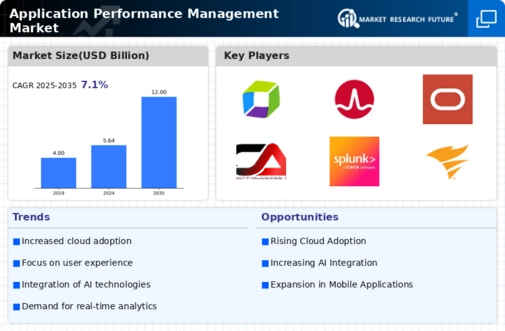Top Industry Leaders in the Application Performance Management Market
Competitive Landscape of the Application Performance Management Market
The Application Performance Management (APM) market is experiencing explosive growth, fueled by the ever-increasing reliance on digital infrastructure and the critical need for optimal application performance. With a projected CAGR exceeding 30% and expected to reach $27.41 billion by 2028, the landscape is fiercely competitive, attracting both established players and nimble newcomers.
Key Players:
- Hewlett Packard (U.S.)
- IBM Corporation (U.S.)
- AppDynamics (U.S.)
- Compuware Corporation (U.S.)
- Oracle Corporation (U.S.)
- Microsoft Corporation (U.S.)
- CA Technologies (U.S.)
Factors for Market Share Analysis:
- Product Features and Functionality: The breadth and depth of APM capabilities, including code-level insights, real-time analytics, AI-powered troubleshooting, and user experience monitoring, play a crucial role in market share.
- Deployment Flexibility: On-premises, cloud-based, and hybrid deployment options cater to diverse customer preferences and infrastructure complexity. Offering flexible deployment models is key to capturing a wider audience.
- Pricing Strategies: Vendors employ varied pricing models, including subscription, pay-per-use, and tiered pricing based on features and usage. Competitive pricing and attractive licensing options influence market share significantly.
- Customer Support and Services: Robust technical support, training programs, and proactive maintenance services enhance customer satisfaction and loyalty, driving market share gains.
- Partner Ecosystem: Strategic partnerships with technology providers, cloud platforms, and system integrators broaden reach and strengthen the overall value proposition, propelling market share growth.
New and Emerging Companies:
- Open-Source Players: Open-source APM solutions like Prometheus and Grafana are gaining traction with their cost-effectiveness and customization options. Their growing communities and active development contribute to market diversification.
- AI-Focused Startups: Startups specializing in AI-powered APM solutions are emerging, promising intelligent anomaly detection, self-healing capabilities, and proactive performance optimization. These innovative offerings could disrupt the market in the future.
Current Investment Trends:
- Cloud-Based Solutions: Investment in cloud-native APM solutions is skyrocketing as businesses increasingly migrate to the cloud. Vendors are focusing on scalability, security, and seamless integration with cloud ecosystems.
- Artificial Intelligence and Machine Learning: AI and ML are being embedded into APM tools for automated root cause analysis, predictive performance insights, and proactive problem-solving. This trend promises significant performance improvements and reduced operating costs.
- User Experience Monitoring: APM solutions are evolving to encompass user experience (UX) monitoring, providing visibility into how application performance impacts end-users. This integrated approach ensures optimal user journeys and improved customer satisfaction.
- Integration with DevOps Tools: APM vendors are actively integrating their solutions with DevOps tools to enable continuous monitoring and performance optimization throughout the software development lifecycle. This fosters collaboration and streamlines application delivery.
Latest Company Updates:
November 3, 2023: Cisco announces AppDynamics, with enhanced AI-powered anomaly detection and improved containerized application monitoring capabilities.
November 15, 2023: Datadog unveils its APM SaaS offering focused on small and medium-sized businesses, promising affordable and easy-to-use application performance monitoring.
December 7, 2023: Sumo Logic partners with Google Cloud to integrate its log management and observability platform with Google Cloud's Anthos, targeting hybrid and multi-cloud environments.
January 10, 2024: Broadcom introduces a new SaaS-based APM offering, highlighting its commitment to cloud-based solutions and expanding its customer base.

